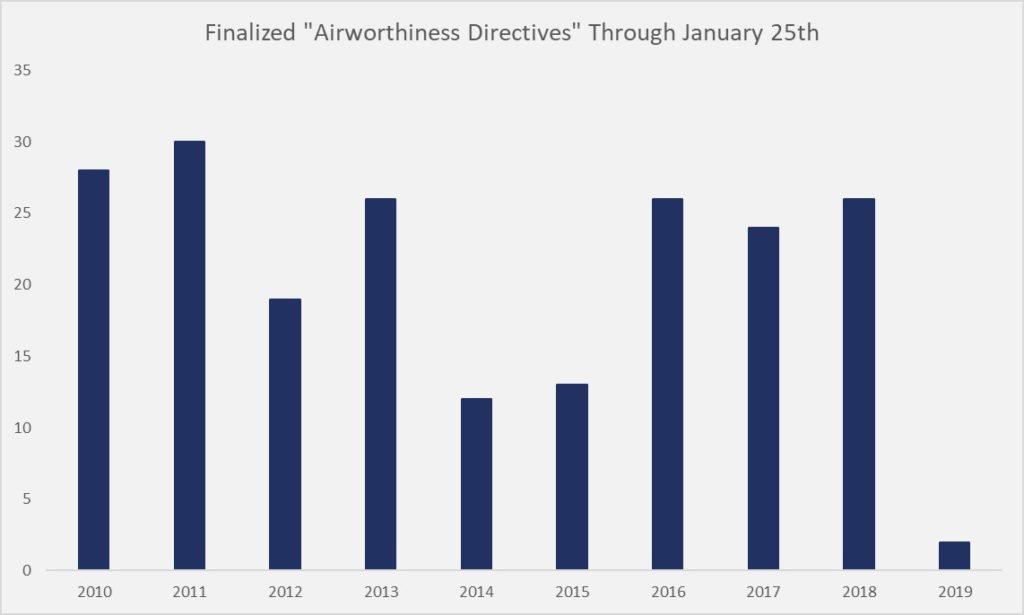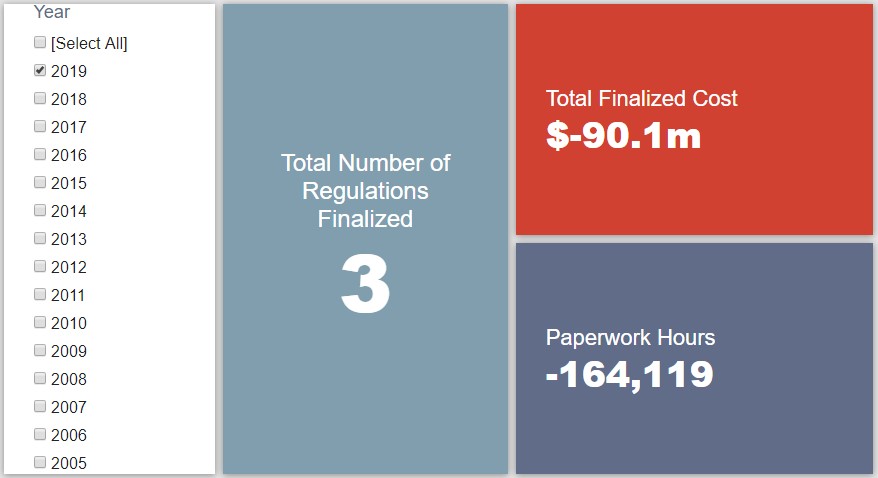Week in Regulation
January 28, 2019
2019 Continues on Deregulatory Track
The partial government shutdown continued through last week, but there were renewed signs of life in the pages of the Federal Register. While the flow of rulemaking activity remains meager, the overall output has remained largely deregulatory in nature. Between both proposed and final rules last week, agencies published $77.4 million in net cost savings, and reduced paperwork burdens by 44,643 hours.
REGULATORY TOPLINES
- New Proposed Rules: 2
- New Final Rules: 4
- 2019 Total Pages: 398
- 2019 Final Rule Costs: -$90.1 Million
- 2019 Proposed Rule Costs: $6.4 Million
TRACKING THE REGULATORY BUDGET
The one rule from last week that affects the fiscal year (FY) 2019 regulatory budget under Executive Order (EO) 13,771 comes from the Department of Labor (DOL). The rule adjusts reporting requirements regarding the “Tracking of Workplace Injuries and Illnesses.” Based upon DOL estimates, these changes would save affected private sector entities roughly $84 million over the course of 10 years (or nearly $9 million when annualized at a 7 percent discount rate). DOL now has two final rules with quantified savings on books for FY 2019 with just over $100 million in net cost reductions.
So far in FY 2019 (which began on October 1, 2018), there have been 24 deregulatory actions (per the rubric created EO 13,771 and the administration’s subsequent guidance document) against nine rules that increase costs and fall under the EO’s reach. Combined, these actions yield quantified net costs of roughly $1.3 billion. This, however, includes the caveat regarding the baseline in the Department of Agriculture’s “National Bioengineered Food Disclosure Standard.” If one considers that rule to actually be deregulatory, the administration-wide net total is approximately $5.4 billion in net savings. The administration’s cumulative savings goal for FY 2019 is approximately $18 billion.
THIS WEEK’S REGULATORY PICTURE
One can describe “regulatory policy” in many ways: mundane, opaque, monotonous, complex, legalistic. The list goes on. In order to help provide a clearer and more straight-forward view into this world, the American Action Forum will seek to provide a brief illustration of a notable regulatory trend we have identified in a given week. This week’s entry: a look the shutdown’s impact on routine airplane regulations.
Flip through the pages of a randomly selected Federal Register issue and one will likely come across at least a handful of rulemakings deemed “Airworthiness Directives” from the Federal Aviation Administration. These straightforward regulations alert relevant aircraft operators of specific safety issues they need to address in their fleets. So far into 2019, there have been two such rules published. The average over a comparable span from 2010-2018 is roughly 23, or slightly less than one per calendar day. Much of the shutdown news has justifiably centered around the implications for security checkpoints and air traffic controllers, but here is yet another otherwise-routine area of air travel that the funding lapse has affected in a notable way.
TOTAL BURDENS
Since January 1, the federal government has published $83.7 million in net cost savings (with $90.1 million in finalized savings and 96,068 hours of paperwork burden reductions (including 164,119 fewer hours from final rules). Click here for the latest Reg Rodeo findings.












